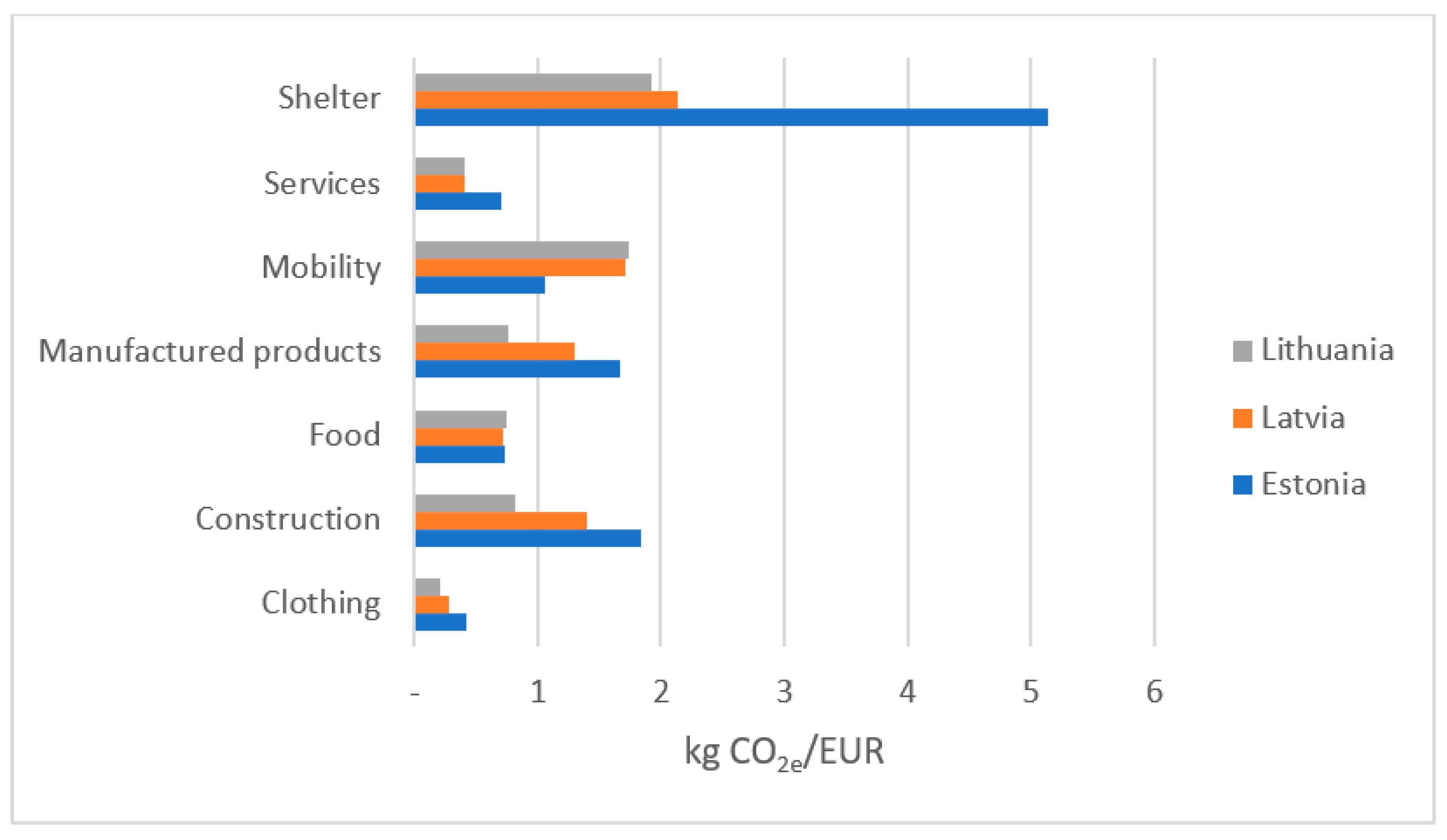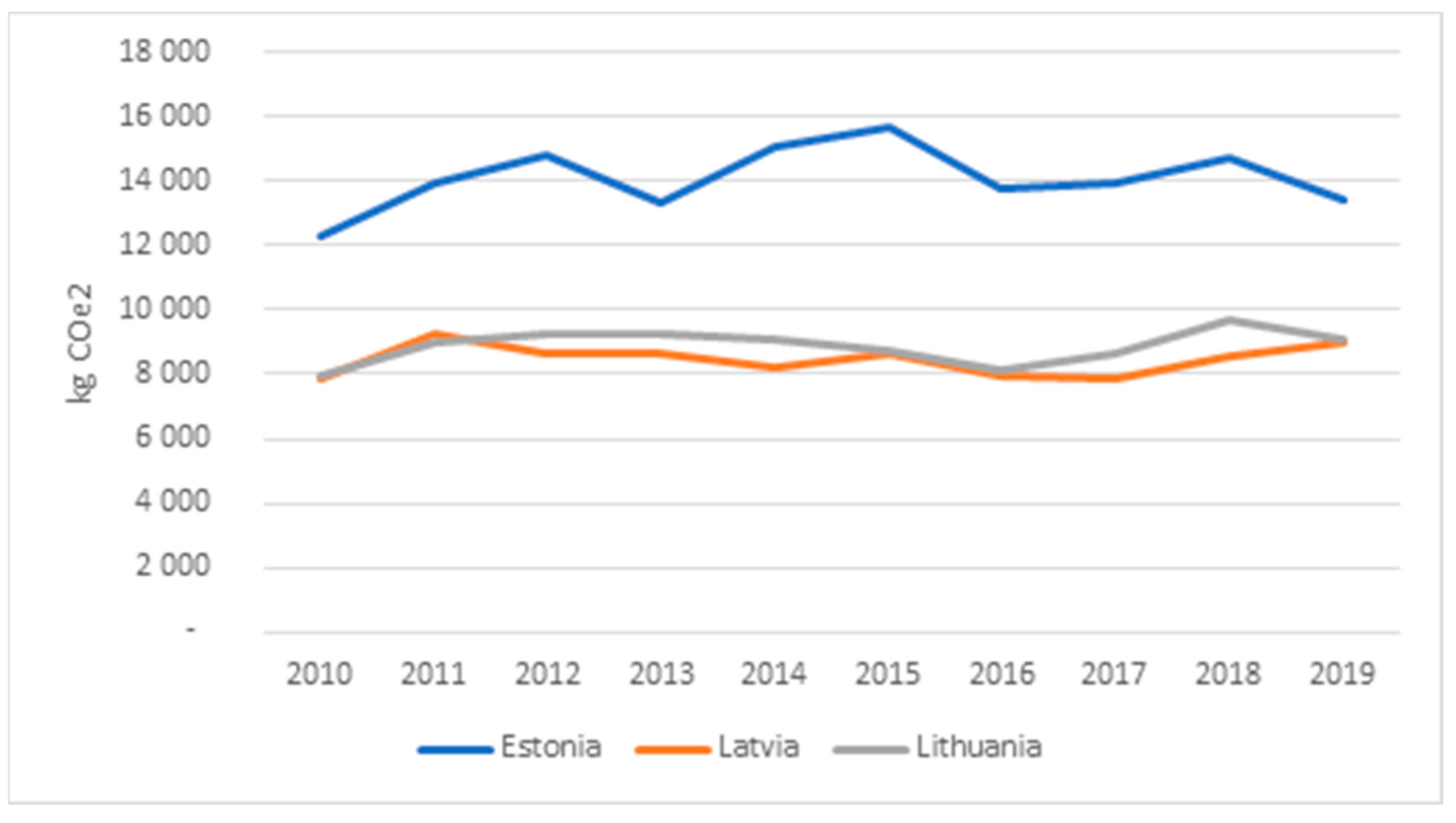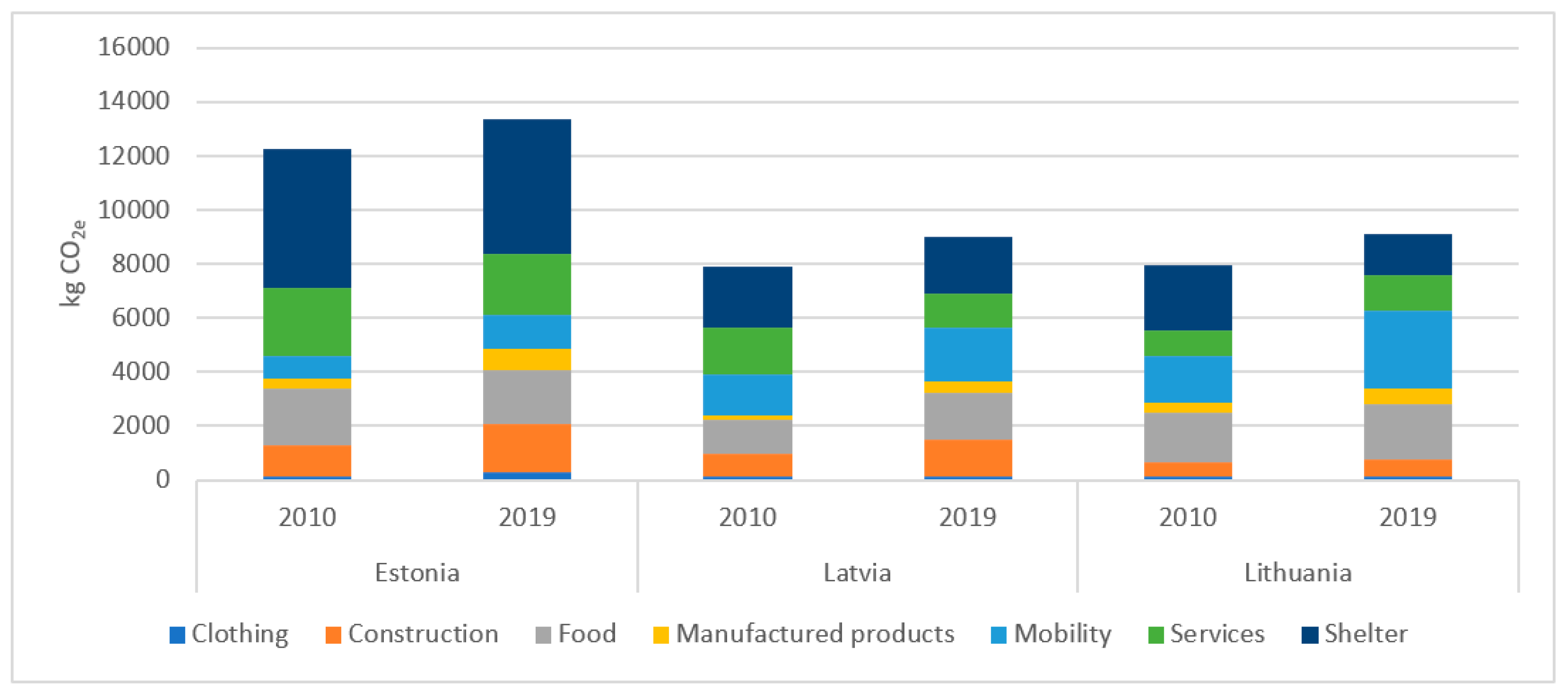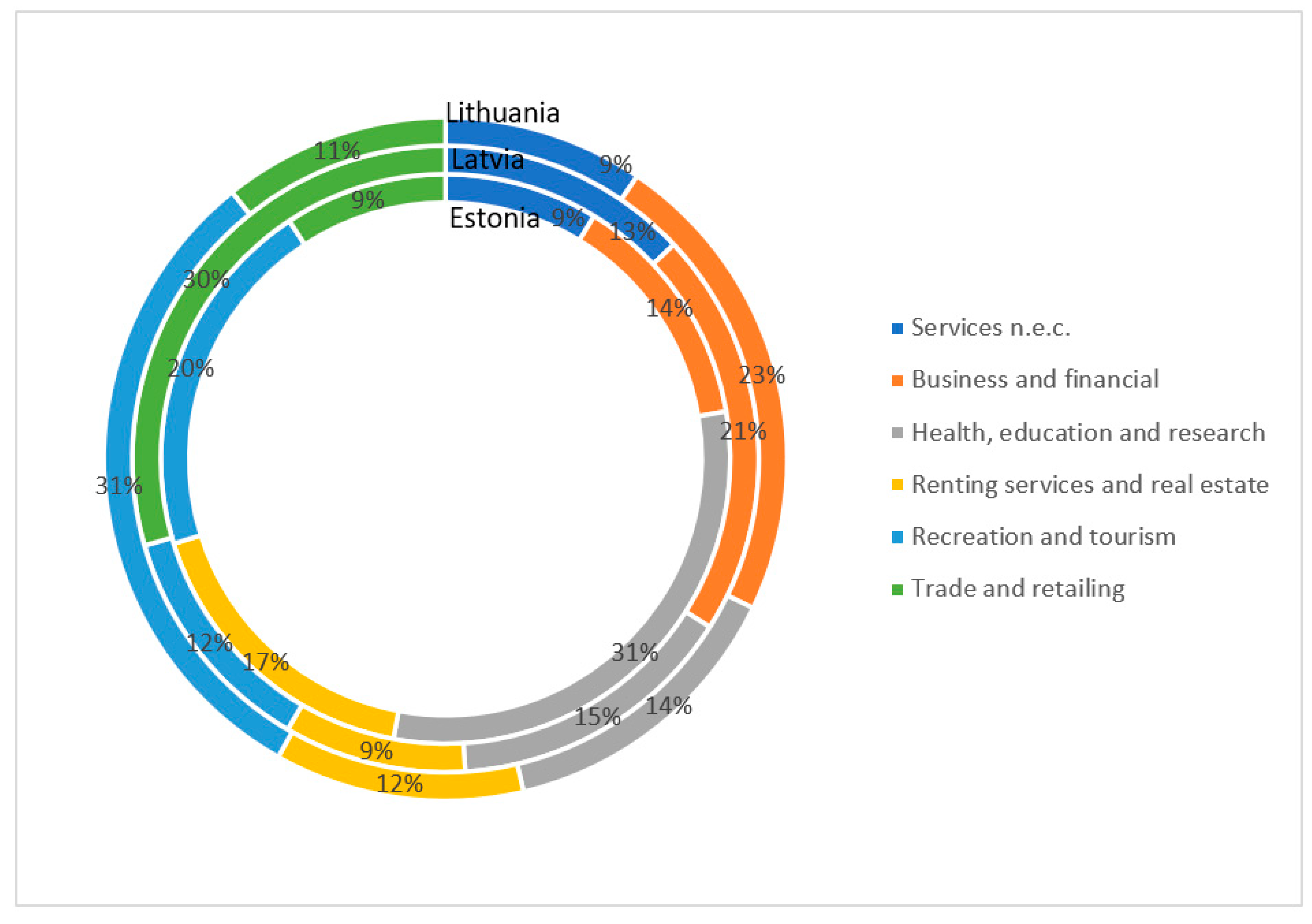Sustainable Consumption in the Baltic States: The Carbon Footprint in the Household Sector
Abstract
:1. Introduction
2. Methodology
3. Results and Discussion
3.1. Household Income and Consumption Level in the Baltic States
3.2. Consumption-Based Carbon Footprint in the Baltic States
3.3. Carbon Footprint According to Consumption Categories
3.3.1. Food
3.3.2. Mobility
3.3.3. Shelter
3.3.4. Services Sector
3.3.5. Other Sectors
4. Conclusions and Policy Implications
- Changes in the diet to balance calories and minimize consumption of animal-based products;
- Consumption of seasonal and local-organic products;
- Energy efficiency improvements and usage of renewable energy resources in the housing sector;
- Switching to public transport and non-motorized means of transportation;
- Decreasing consumption of energy-intensive products and services;
- Extending the lifespan of the manufactured products;
- Encouraging companies through subsidies to produce more environmentally friendly products;
5. Limitations and Avenues for Future Research
Author Contributions
Funding
Institutional Review Board Statement
Informed Consent Statement
Data Availability Statement
Acknowledgments
Conflicts of Interest
References
- Akenji, L.; Bengtsson, M. Making sustainable consumption and production the core of sustainable development goals. Sustainability 2014, 6, 513–529. [Google Scholar] [CrossRef] [Green Version]
- Wang, C.; Ghadimi, P.; Lim, M.K.; Tseng, M.L. A literature review of sustainable consumption and production: A comparative analysis in developed and developing economies. J. Clean. Prod. 2019, 206, 741–754. [Google Scholar] [CrossRef]
- Gunawan, J.; Permatasari, P.; Tilt, C. Sustainable development goal disclosures: Do they support responsible consumption and production? J. Clean. Prod. 2020, 246, 118989. [Google Scholar] [CrossRef]
- Dubey, R.; Gunasekaran, A.; Childe, S.J.; Luo, Z.; Wamba, S.F.; Roubaud, D.; Foropon, C. Examining the role of big data and predictive analytics on collaborative performance in context to sustainable consumption and production behaviour. J. Clean. Prod. 2018, 196, 1508–1521. [Google Scholar] [CrossRef]
- Tseng, M.L.; Tan, R.R.; Siriban-Manalang, A.B. Sustainable consumption and production for Asia: Sustainability through green design and practice. J. Clean. Prod. 2013, 40, 1–5. [Google Scholar] [CrossRef]
- Brizga, J.; Feng, K.; Hubacek, K. Household carbon footprints in the Baltic States: A global multi-regional input–output analysis from 1995 to 2011. Appl. Energy 2017, 189, 780–788. [Google Scholar] [CrossRef]
- Dubey, R.; Gunasekaran, A.; Childe, S.J.; Papadopoulos, T.; Wamba, S.F.; Song, M. Towards a theory of sustainable consumption and production: Constructs and measurement. Resour. Conserv. Recycl. 2016, 106, 78–89. [Google Scholar] [CrossRef]
- Vergragt, P.J.; Dendler, L.; De Jong, M.; Matus, K. Transitions to sustainable consumption and production in cities. J. Clean. Prod. 2016, 134, 1–12. [Google Scholar] [CrossRef]
- Mangla, S.K.; Govindan, K.; Luthra, S. Prioritizing the barriers to achieve sustainable consumption and production trends in supply chains using fuzzy Analytical Hierarchy Process. J. Clean. Prod. 2017, 151, 509–525. [Google Scholar] [CrossRef]
- Bengtsson, M.; Alfredsson, E.; Cohen, M.; Lorek, S.; Schroeder, P. Transforming systems of consumption and production for achieving the sustainable development goals: Moving beyond efficiency. Sustain. Sci. 2018, 13, 1533–1547. [Google Scholar] [CrossRef]
- Tseng, M.L.; Chiu, A.S.; Liu, G.; Jantaralolica, T. Circular economy enables sustainable consumption and production in multi-level supply chain system. Resour. Conserv. Recycl. 2020, 154, 104601. [Google Scholar] [CrossRef]
- Marrucci, L.; Daddi, T.; Iraldo, F. The integration of circular economy with sustainable consumption and production tools: Systematic review and future research agenda. J. Clean. Prod. 2019, 240, 118268. [Google Scholar] [CrossRef]
- Cohen, B.; Muñoz, P. Sharing cities and sustainable consumption and production: Towards an integrated framework. J. Clean. Prod. 2016, 134, 87–97. [Google Scholar] [CrossRef]
- Ma, Y.; Rong, K.; Luo, Y.; Wang, Y.; Mangalagiu, D.; Thornton, T.F. Value Co-creation for sustainable consumption and production in the sharing economy in China. J. Clean. Prod. 2019, 208, 1148–1158. [Google Scholar] [CrossRef]
- Liobikienė, G.; Dagiliūtė, R. The relationship between economic and carbon footprint changes in EU: The achievements of the EU Sustainable Consumption and Production policy implementation. Environ. Sci. Policy 2016, 61, 204–211. [Google Scholar] [CrossRef]
- Marrucci, L.; Daddi, T. The contribution of the Eco-Management and Audit Scheme to the environmental performance of manufacturing organisations. Bus. Strategy Environ. 2021. [Google Scholar] [CrossRef]
- Caputo, F.; Buhnova, B.; Walletzký, L. Investigating the role of smartness for sustainability: Insights from the Smart Grid domain. Sustain. Sci. 2018, 13, 1299–1309. [Google Scholar] [CrossRef]
- Trischler, J.; Johnson, M.; Kristensson, P. A service ecosystem perspective on the diffusion of sustainability-oriented user innovations. J. Bus. Res. 2020, 116, 552–560. [Google Scholar] [CrossRef]
- Jonkutė, G.; Staniškis, J.K. Realising sustainable consumption and production in companies: The SURESCOM model. J. Clean. Prod. 2016, 138, 170–180. [Google Scholar] [CrossRef]
- Stumpf, L.; Schöggl, J.P.; Baumgartner, R.J. Climbing up the circularity ladder?–A mixed-methods analysis of circular economy in business practice. J. Clean. Prod. 2021, 316, 128158. [Google Scholar] [CrossRef]
- Caputo, F. Towards a holistic view of corporate social responsibility. The antecedent role of information asymmetry and cognitive distance. Kybernetes 2021, 50, 639–655. [Google Scholar] [CrossRef]
- Calabrese, A.; Castaldi, C.; Forte, G.; Levialdi, N.G. Sustainability-oriented service innovation: An emerging research field. J. Clean. Prod. 2018, 193, 533–548. [Google Scholar] [CrossRef]
- Dangelico, R.M.; Pujari, D.; Pontrandolfo, P. Green product innovation in manufacturing firms: A sustainability-oriented dynamic capability perspective. Bus. Strategy Environ. 2017, 26, 490–506. [Google Scholar] [CrossRef]
- Varadarajan, R. Innovating for sustainability: A framework for sustainable innovations and a model of sustainable innovations orientation. J. Acad. Mark. Sci. 2017, 45, 14–36. [Google Scholar] [CrossRef]
- Lehtoranta, S.; Nissinen, A.; Mattila, T.M. Industrial symbiosis and the policy instruments of sustainable consumption and production. J. Clean. Prod. 2011, 19, 1865–1875. [Google Scholar] [CrossRef]
- Charter, M.; Gray, C.; Clark, T.; Woolman, T. The role of business in realising sustainable consumption and production. In System Innovation for Sustainability 1: Perspectives on Radical Changes to Sustainable Consumption and Production; Routledge: London, UK, 2017; pp. 46–69. [Google Scholar]
- Yagi, M.; Kokubu, K. A framework of sustainable consumption and production from the production perspective: Application to Thailand and Vietnam. J. Clean. Prod. 2020, 276, 124160. [Google Scholar] [CrossRef]
- Sarkis, J.; Cohen, M.J.; Dewick, P.; Schröder, P. A brave new world: Lessons from the COVID-19 pandemic for transitioning to sustainable supply and production. Resour. Conserv. Recycl. 2020, 159, 104894. [Google Scholar] [CrossRef]
- Martins, V.W.B.; Rampasso, I.S.; Siltori, P.F.S.; Cazeri, G.T.; Anholon, R.; Quelhas, O.L.G.; Leal Filho, W. Contributions from the Brazilian industrial sector to sustainable development. J. Clean. Prod. 2020, 272, 122762. [Google Scholar] [CrossRef]
- Schrader, U.; Thøgersen, J. Putting sustainable consumption into practice. J. Consum. Policy 2011, 34, 3–8. [Google Scholar] [CrossRef] [Green Version]
- Lorek, S.; Spangenberg, J.H. Sustainable consumption within a sustainable economy–beyond green growth and green economies. J. Clean. Prod. 2014, 63, 33–44. [Google Scholar] [CrossRef]
- Reisch, L.A.; Cohen, M.J.; Thøgersen, J.B.; Tukker, A. Frontiers in sustainable consumption research. GAIA-Ecol. Perspect. Sci. Soc. 2016, 25, 234–240. [Google Scholar] [CrossRef]
- Shao, J.; Taisch, M.; Mier, M.O. Influencing factors to facilitate sustainable consumption: From the experts‘ viewpoints. J. Clean. Prod. 2017, 142, 203–216. [Google Scholar] [CrossRef]
- Liu, W.; Oosterveer, P.; Spaargaren, G. Promoting sustainable consumption in China: A conceptual framework and research review. J. Clean. Prod. 2016, 134, 13–21. [Google Scholar] [CrossRef]
- Lakatos, E.S.; Cioca, L.I.; Dan, V.; Ciomos, A.O.; Crisan, O.A.; Barsan, G. Studies and investigation about the attitude towards sustainable production, consumption and waste generation in line with circular economy in Romania. Sustainability 2018, 10, 865. [Google Scholar] [CrossRef] [Green Version]
- Welch, D.; Southerton, D. After Paris: Transitions for sustainable consumption. Sustain. Sci. Pract. Policy 2019, 15, 31–44. [Google Scholar] [CrossRef] [Green Version]
- Tunn, V.S.C.; Bocken, N.M.P.; van den Hende, E.A.; Schoormans, J.P.L. Business models for sustainable consumption in the circular economy: An expert study. J. Clean. Prod. 2019, 212, 324–333. [Google Scholar] [CrossRef]
- Legere, A.; Kang, J. The role of self-concept in shaping sustainable consumption: A model of slow fashion. J. Clean. Prod. 2020, 258, 120699. [Google Scholar] [CrossRef]
- Hernandez, R.J.; Miranda, C.; Goñi, J. Empowering sustainable consumption by giving back to consumers the ‘right to repair’. Sustainability 2020, 12, 850. [Google Scholar] [CrossRef] [Green Version]
- Severo, E.A.; De Guimarães, J.C.F.; Dellarmelin, M.L. Impact of the COVID-19 pandemic on environmental awareness, sustainable consumption and social responsibility: Evidence from generations in Brazil and Portugal. J. Clean. Prod. 2021, 286, 124947. [Google Scholar] [CrossRef]
- Bălan, C. How Does Retail Engage Consumers in Sustainable Consumption? A Systematic Literature Review. Sustainability 2021, 13, 96. [Google Scholar] [CrossRef]
- Staniškis, J.K. Sustainable consumption and production: How to make it possible. Clean Technol. Environ. Policy 2012, 14, 1015–1022. [Google Scholar] [CrossRef]
- Ülkü, M.A.; Hsuan, J. Towards sustainable consumption and production: Competitive pricing of modular products for green consumers. J. Clean. Prod. 2017, 142, 4230–4242. [Google Scholar] [CrossRef]
- Tukker, A.; Emmert, S.; Charter, M.; Vezzoli, C.; Sto, E.; Andersen, M.M.; Lahlou, S. Fostering change to sustainable consumption and production: An evidence based view. J. Clean. Prod. 2008, 16, 1218–1225. [Google Scholar] [CrossRef]
- Marrucci, L.; Iraldo, F.; Daddi, T. Investigating the management challenges of the EU Ecolabel through multi-stakeholder surveys. Int. J. Life Cycle Assess. 2021, 26, 575–590. [Google Scholar] [CrossRef]
- Borusiak, B.; Szymkowiak, A.; Horska, E.; Raszka, N.; Żelichowska, E. Towards building sustainable consumption: A study of second-hand buying intentions. Sustainability 2020, 12, 875. [Google Scholar] [CrossRef] [Green Version]
- Lukman, R.K.; Glavič, P.; Carpenter, A.; Virtič, P. Sustainable consumption and production–Research, experience, and development–The Europe we want. J. Clean. Prod. 2016, 138, 139–147. [Google Scholar] [CrossRef]
- Caeiro, S.; Ramos, T.B.; Huisingh, D. Procedures and criteria to develop and evaluate household sustainable consumption indicators. J. Clean. Prod. 2012, 27, 72–91. [Google Scholar] [CrossRef]
- Fuchs, D.; Di Giulio, A.; Glaab, K.; Lorek, S.; Maniates, M.; Princen, T.; Røpke, I. Power: The missing element in sustainable consumption and absolute reductions research and action. J. Clean. Prod. 2016, 132, 298–307. [Google Scholar] [CrossRef]
- Suski, P.; Speck, M.; Liedtke, C. Promoting sustainable consumption with LCA–A social practice based perspective. J. Clean. Prod. 2021, 283, 125234. [Google Scholar] [CrossRef]
- Shittu, O. Emerging sustainability concerns and policy implications of urban household consumption: A systematic literature review. J. Clean. Prod. 2020, 246, 119034. [Google Scholar] [CrossRef]
- Zhang, J.; Yu, B.; Cai, J.; Wei, Y.M. Impacts of household income change on CO2 emissions: An empirical analysis of China. J. Clean. Prod. 2017, 157, 190–200. [Google Scholar] [CrossRef]
- Heinonen, J.; Ottelin, J.; Ala-Mantila, S.; Wiedmann, T.; Clarke, J.; Junnila, S. Spatial consumption-based carbon footprint assessments-A review of recent developments in the field. J. Clean. Prod. 2020, 256, 120335. [Google Scholar] [CrossRef]
- Burgui-Burgui, M.; Chuvieco, E. Beyond Carbon Footprint Calculators. New Approaches for Linking Consumer Behaviour and Climate Action. Sustainability 2020, 12, 6529. [Google Scholar] [CrossRef]
- Paravantis, J.A.; Tasios, P.D.; Dourmas, V.; Andreakos, G.; Velaoras, K.; Kontoulis, N.; Mihalakakou, P. A Regression Analysis of the Carbon Footprint of Megacities. Sustainability 2021, 13, 1379. [Google Scholar] [CrossRef]
- Chen, R.; Zhang, R.; Han, H. Where has carbon footprint research gone? Ecol. Indic. 2021, 120, 106882. [Google Scholar] [CrossRef]
- Marrucci, L.; Marchi, M.; Daddi, T. Improving the carbon footprint of food and packaging waste management in a supermarket of the Italian retail sector. Waste Manag. 2020, 105, 594–603. [Google Scholar] [CrossRef] [PubMed]
- Jones, C.M.; Kammen, D.M. Quantifying carbon footprint reduction opportunities for US households and communities. Environ. Sci. Technol. 2011, 45, 4088–4095. [Google Scholar] [CrossRef]
- Shirley, R.; Jones, C.; Kammen, D. A household carbon footprint calculator for islands: Case study of the United States Virgin Islands. Ecol. Econ. 2012, 80, 8–14. [Google Scholar] [CrossRef] [Green Version]
- Steen-Olsen, K.; Wood, R.; Hertwich, E.G. The carbon footprint of Norwegian household consumption 1999–2012. J. Ind. Ecol. 2016, 20, 582–592. [Google Scholar] [CrossRef]
- Isaksen, E.T.; Narbel, P.A. A carbon footprint proportional to expenditure-A case for Norway? Ecol. Econ. 2017, 131, 152–165. [Google Scholar] [CrossRef] [Green Version]
- Tian, X.; Geng, Y.; Dong, H.; Dong, L.; Fujita, T.; Wang, Y.; Sun, L. Regional household carbon footprint in China: A case of Liaoning province. J. Clean. Prod. 2016, 114, 401–411. [Google Scholar] [CrossRef]
- Wiedenhofer, D.; Guan, D.; Liu, Z.; Meng, J.; Zhang, N.; Wei, Y.M. Unequal household carbon footprints in China. Nat. Clim. Chang. 2017, 7, 75–80. [Google Scholar] [CrossRef] [Green Version]
- Zhao, Y.; Zhang, Q.; Li, F.Y. Patterns and drivers of household carbon footprint of the herdsmen in the typical steppe region of inner Mongolia, China: A case study in Xilinhot City. J. Clean. Prod. 2019, 232, 408–416. [Google Scholar] [CrossRef]
- Chen, C.; Liu, G.; Meng, F.; Hao, Y.; Zhang, Y.; Casazza, M. Energy consumption and carbon footprint accounting of urban and rural residents in Beijing through Consumer Lifestyle Approach. Ecol. Indic. 2019, 98, 575–586. [Google Scholar] [CrossRef]
- Yin, X.; Hao, Y.; Yang, Z.; Zhang, L.; Su, M.; Cheng, Y.; Liang, S. Changing carbon footprint of urban household consumption in Beijing: Insight from a nested input-output analysis. J. Clean. Prod. 2020, 258, 120698. [Google Scholar] [CrossRef]
- Wang, X.; Chen, S. Urban-rural carbon footprint disparity across China from essential household expenditure: Survey-based analysis, 2010–2014. J. Environ. Manag. 2020, 267, 110570. [Google Scholar] [CrossRef]
- Long, Y.; Yoshida, Y.; Fang, K.; Zhang, H.; Dhondt, M. City-level household carbon footprint from purchaser point of view by a modified input-output model. Appl. Energy 2019, 236, 379–387. [Google Scholar] [CrossRef]
- Long, Y.; Yoshida, Y.; Dong, L. Exploring the indirect household carbon emissions by source: Analysis on 49 Japanese cities. J. Clean. Prod. 2017, 167, 571–581. [Google Scholar] [CrossRef]
- Salo, M.; Savolainen, H.; Karhinen, S.; Nissinen, A. Drivers of household consumption expenditure and carbon footprints in Finland. J. Clean. Prod. 2021, 289, 125607. [Google Scholar] [CrossRef]
- Miehe, R.; Scheumann, R.; Jones, C.M.; Kammen, D.M.; Finkbeiner, M. Regional carbon footprints of households: A German case study. Environ. Dev. Sustain. 2016, 18, 577–591. [Google Scholar] [CrossRef] [Green Version]
- Sommer, M.; Kratena, K. The carbon footprint of European households and income distribution. Ecol. Econ. 2017, 136, 62–72. [Google Scholar] [CrossRef] [Green Version]
- Salo, M.; Mattinen-Yuryev, M.K.; Nissinen, A. Opportunities and limitations of carbon footprint calculators to steer sustainable household consumption–Analysis of Nordic calculator features. J. Clean. Prod. 2019, 207, 658–666. [Google Scholar] [CrossRef]
- Sköld, B.; Baltruszewicz, M.; Aall, C.; Andersson, C.; Herrmann, A.; Amelung, D.; Sauerborn, R. Household preferences to reduce their greenhouse gas footprint: A comparative study from four European cities. Sustainability 2018, 10, 4044. [Google Scholar] [CrossRef] [Green Version]
- Markaki, M.; Belegri-Roboli, A.; Sarafidis, Υ.; Mirasgedis, S. The carbon footprint of Greek households (1995–2012). Energy Policy 2017, 100, 206–215. [Google Scholar] [CrossRef]
- Tabi, A. Does pro-environmental behaviour affect carbon emissions? Energy Policy 2013, 63, 972–981. [Google Scholar] [CrossRef]
- Tolppanen, S.; Kang, J. The effect of values on carbon footprint and attitudes towards pro-environmental behavior. J. Clean. Prod. 2021, 282, 124524. [Google Scholar] [CrossRef]
- Testa, F.; Iovino, R.; Iraldo, F. The circular economy and consumer behaviour: The mediating role of information seeking in buying circular packaging. Bus. Strategy Environ. 2020, 29, 3435–3448. [Google Scholar] [CrossRef]
- Tukker, A.; Wood, R.; Giljum, S.; Hubacek, K. Special Issue on the Global Multi Regional Input Output Database “EXIOBASE”. J. Ind. Ecol. 2018, 22, 3. [Google Scholar]
- Peters, G.P. Carbon footprints and embodied carbon at multiple scales. Curr. Opin. Environ. Sustain. 2010, 2, 245–250. [Google Scholar] [CrossRef]
- Stadler, K.; Wood, R.; Bulavskaya, T.; Södersten, C.J.; Simas, M.; Schmidt, S.; Usubiaga, A.; Acosta-Fernández, J.; Kuenen, J.; Bruckner, M. EXIOBASE 3: Developing a time series of detailed environmentally extended multi-regional input-output tables. J. Ind. Ecol. 2018, 22, 502–515. [Google Scholar] [CrossRef] [Green Version]
- Eurostat. Real GDP Growth Rate-Volume. Code: Tec00115. 2020. Available online: https://ec.europa.eu/eurostat/web/products-datasets/-/tec00115&lang=en (accessed on 20 September 2021).
- Eurostat. Real GDP per Capita. Code: SDG_08_10. 2020. Available online: https://ec.europa.eu/eurostat/databrowser/view/sdg_08_10/default/table?lang=en (accessed on 20 September 2021).
- Cyrek, M.; Cyrek, P. Does Economic Structure Differentiate the Achievements towards Energy SDG in the EU? Energies 2021, 14, 2229. [Google Scholar] [CrossRef]
- Dogan, E.; Inglesi-Lotz, R. The impact of economic structure to the environmental Kuznets curve (EKC) hypothesis: Evidence from European countries. Environ. Sci. Pollut. Res. 2020, 27, 12717–12724. [Google Scholar] [CrossRef] [PubMed]
- Ljovkina, A.O.; Dusseault, D.L.; Zaharova, O.V.; Klochkov, Y. Managing innovation resources in accordance with sustainable development ethics: Typological analysis. Resources 2019, 8, 82. [Google Scholar] [CrossRef] [Green Version]
- DnB NORD. Latvijas Barometrs nr. 38: Patēriņš: Latvian. 2011. Available online: https://www.luminor.lv/lv/dnb-latvijas-barometrs (accessed on 20 September 2021).
- Liobikienė, G.; Mandravickaitė, J.; Bernatonienė, J. Theory of planned behavior approach to understand the green purchasing behavior in the EU: A cross-cultural study. Ecol. Econ. 2016, 125, 38–46. [Google Scholar] [CrossRef]
- Streimikiene, D. Low Carbon Energy Transition of Baltic States. Montenegrin J. Econ. 2021, 17, 219–230. [Google Scholar] [CrossRef]
- Jakučionytė-Skodienė, M.; Liobikienė, G. Climate change concern, personal responsibility and actions related to climate change mitigation in EU countries: Cross-cultural analysis. J. Clean. Prod. 2021, 281, 125189. [Google Scholar] [CrossRef]
- Berkhout, P.H.; Muskens, J.C.; Velthuijsen, J.W. Defining the rebound effect. Energy Policy 2000, 28, 425–432. [Google Scholar] [CrossRef]
- Wen, F.; Ye, Z.; Yang, H.; Li, K. Exploring the rebound effect from the perspective of household: An analysis of China’s provincial level. Energy Econ. 2018, 75, 345–356. [Google Scholar] [CrossRef]
- Walzberg, J.; Dandres, T.; Merveille, N.; Cheriet, M.; Samson, R. Should we fear the rebound effect in smart homes? Renew. Sustain. Energy Rev. 2020, 125, 109798. [Google Scholar] [CrossRef]
- Yue, Q.; Xu, X.; Hillier, J.; Cheng, K.; Pan, G. Mitigating greenhouse gas emissions in agriculture: From farm production to food consumption. J. Clean. Prod. 2017, 149, 1011–1019. [Google Scholar] [CrossRef]
- FAO Stat. Food and Agriculture Organisation of the UN (FAO) Statistics Database: Production, Trade, Supply; FAO: Rome, Italy, 2019. [Google Scholar]
- MAXIMA. Maxima Mazumtirdzniecības Kompass: Iedzīvotāju Iepirkšanās Paradumi. 2020. Available online: https://www.maxima.lv/fileman/Uploads/2020/Kompass/Mazumtirdzniecibas_kompass_novembris_2020.pdf (accessed on 20 September 2021).
- Siksna, I.; Uturytė, L.; Karu, K.; Vanhalst, J. The COVID-19 Pandemic and Food Consumption Patterns; Nordic Council of Ministers: Copenhagen, Denmark, 2021.
- Pekala, A. Market Analysis of Organic Foods in the Nordic and Baltic Countries; Nordic Council of Ministers: Copenhagen, Denmark, 2020.
- Eurostat. Passenger Cars per 1000 Inhabitants [road_eqs_carhab]. 2020. Available online: https://appsso.eurostat.ec.europa.eu/nui/show.do?dataset=road_eqs_carhab&lang=en (accessed on 20 September 2021).
- Barisa, A.; Rosa, M. Scenario analysis of CO2 emission reduction potential in road transport sector in Latvia. Energy Procedia 2018, 147, 86–95. [Google Scholar] [CrossRef]
- EC. Special Eurobarometer 495: Mobility and Transport; European Commission: Brussels, Belgium, 2020. [Google Scholar]
- Minelgaitė, A.; Dagiliūtė, R.; Liobikienė, G. The usage of public transport and impact of satisfaction in the European Union. Sustainability 2020, 12, 9154. [Google Scholar] [CrossRef]
- Croci, E.; Lucchitta, B.; Janssens-Maenhout, G.; Martelli, S.; Molteni, T. Urban CO2 mitigation strategies under the Covenant of Mayors: An assessment of 124 European cities. J. Clean. Prod. 2017, 169, 161–177. [Google Scholar] [CrossRef]
- Duarte, R.; Feng, K.; Hubacek, K.; Sánchez-Chóliz, J.; Sarasa, C.; Sun, L. Modeling the carbon consequences of pro-environmental consumer behavior. Appl. Energy 2016, 184, 1207–1216. [Google Scholar] [CrossRef]
- Abubakar, I.R.; Dano, U.L. Sustainable urban planning strategies for mitigating climate change in Saudi Arabia. Environ. Dev. Sustain. 2019, 22, 5129–5152. [Google Scholar] [CrossRef]
- Borck, R. Public transport and urban pollution. Reg. Sci. Urban Econ. 2019, 77, 356–366. [Google Scholar] [CrossRef] [Green Version]
- Hess, D.B. Decrypting fare-free public transport in Tallinn, Estonia. Case Stud. Transp. Policy 2017, 5, 690–698. [Google Scholar] [CrossRef]
- Brand, C.; Götschi, T.; Dons, E.; Gerike, R.; Anaya-Boig, E.; Avila-Palencia, I.; Nieuwenhuijsen, M.J. The climate change mitigation impacts of active travel: Evidence from a longitudinal panel study in seven European cities. Glob. Environ. Chang. 2021, 67, 102224. [Google Scholar] [CrossRef]
- Abu-Rayash, A.; Dincer, I. Analysis of mobility trends during the COVID-19 coronavirus pandemic: Exploring the impacts on global aviation and travel in selected cities. Energy Res. Soc. Sci. 2020, 68, 101693. [Google Scholar] [CrossRef]
- Eurostat. Average Household Size-EU-SILC Survey. 2020. Available online: https://appsso.eurostat.ec.europa.eu/nui/show.do?dataset=ilc_lvph01&lang=en (accessed on 20 September 2021).
- Eurostat. Is Your Home Too Crowded? 2020. Available online: https://ec.europa.eu/eurostat/web/products-eurostat-news/-/ddn-20200422-1 (accessed on 20 September 2021).
- ODYSSEE-MURE. Energy Efficiency Indicators for Europe-KEY INDICATORS. Enerdata, Ed.. 2021. Available online: https://www.odyssee-mure.eu/ (accessed on 20 September 2021).
- Pichler, P.-P.; Jaccard, I.S.; Weisz, U.; Weisz, H. International comparison of health care carbon footprints. Environ. Res. Lett. 2019, 14, 064004. [Google Scholar] [CrossRef] [Green Version]
- Cordella, M.; Alfieri, F.; Sanfelix, J. Reducing the carbon footprint of ICT products through material efficiency strategies: A life cycle analysis of smartphones. J. Ind. Ecol. 2021, 25, 448–464. [Google Scholar] [CrossRef]
- Vita, G.; Rao, N.D.; Usubiaga-Liaño, A.; Min, J.; Wood, R. Durable Goods Drive Two-Thirds of Global Households’ Final Energy Footprints. Environ. Sci. Technol. 2021, 55, 3175–3187. [Google Scholar] [CrossRef] [PubMed]
- Testa, F.; Iraldo, F. Shadows and lights of GSCM (Green Supply Chain Management): Determinants and effects of these practices based on a multi-national study. J. Clean. Prod. 2010, 18, 953–962. [Google Scholar] [CrossRef] [Green Version]
- Caputo, F.; Carrubbo, L.; Sarno, D. The influence of cognitive dimensions on the consumer-SME relationship: A sustainability-oriented view. Sustainability 2018, 10, 3238. [Google Scholar] [CrossRef] [Green Version]
- Daddi, T.; Heras-Saizarbitoria, I.; Marrucci, L.; Rizzi, F.; Testa, F. The effects of green supply chain management capability on the internalisation of environmental management systems and organisation performance. Corp. Soc. Responsib. Environ. Manag. 2021, 28, 1241–1253. [Google Scholar] [CrossRef]
- Marrucci, L.; Daddi, T.; Iraldo, F. The contribution of green human resource management to the circular economy and performance of environmental certified organisations. J. Clean. Prod. 2021, 319, 128859. [Google Scholar] [CrossRef]
- Testa, F.; Corsini, F.; Gusmerotti, N.M.; Iraldo, F. Predictors of organizational citizenship behavior in relation to environmental and health & safety issues. Int. J. Hum. Resour. Manag. 2020, 31, 1705–1738. [Google Scholar]





Publisher’s Note: MDPI stays neutral with regard to jurisdictional claims in published maps and institutional affiliations. |
© 2022 by the authors. Licensee MDPI, Basel, Switzerland. This article is an open access article distributed under the terms and conditions of the Creative Commons Attribution (CC BY) license (https://creativecommons.org/licenses/by/4.0/).
Share and Cite
Liobikienė, G.; Brizga, J. Sustainable Consumption in the Baltic States: The Carbon Footprint in the Household Sector. Sustainability 2022, 14, 1567. https://doi.org/10.3390/su14031567
Liobikienė G, Brizga J. Sustainable Consumption in the Baltic States: The Carbon Footprint in the Household Sector. Sustainability. 2022; 14(3):1567. https://doi.org/10.3390/su14031567
Chicago/Turabian StyleLiobikienė, Genovaitė, and Jānis Brizga. 2022. "Sustainable Consumption in the Baltic States: The Carbon Footprint in the Household Sector" Sustainability 14, no. 3: 1567. https://doi.org/10.3390/su14031567
APA StyleLiobikienė, G., & Brizga, J. (2022). Sustainable Consumption in the Baltic States: The Carbon Footprint in the Household Sector. Sustainability, 14(3), 1567. https://doi.org/10.3390/su14031567






